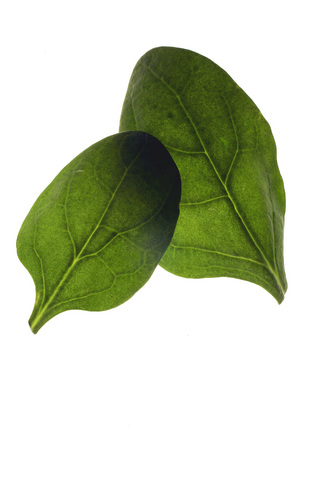There was a time when Popeye was strictly a can man: Nothing but spinach in a tin for the surly sailor-man. But times change, and so did Popeye, and as fresh spinach became all the rage with a health-conscious public, the cartoon character's jowly mug got plastered on bags of fresh spinach.
Now, as disease sleuths track a deadly outbreak of E. coli germs blamed on tainted fresh spinach, there's evidence that the sailor had it right back in the old days.
“We have failed to profit from the early example of Popeye,” said Dean Cliver, a food safety professor at the University of California at Davis. “One of the most honored traditions of the human race is learning to cook things so they don't kill us.”

PHOTOS: NY TIMES NEWS SERVICE
That's as true for spinach as it is for beef, which is more often linked with E. coli in the public consciousness. The only way to kill the E. coli that burrow into the nooks and crannies of leafy, ground-dwelling vegetables like spinach is through cooking, or eating spinach from a can, which has already been subjected to high-heat sterilization.
So, until investigators figure out how spinach from central California was contaminated and safeguards are adopted, agriculture specialists recommend avoiding fresh spinach. More than 170 people in 25 states were sickened, apparently by the spinach.
To be sure, the vegetables and fruits and meat we consume today are, overall, vastly safer than the putrid mess that the author Upton Sinclair exposed a century ago in The Jungle. At the same time, our tastes and expectations have changed: We want our vegetables to come bagged and fresh and assume that means they're healthier.

“This episode definitely shakes and undermines consumers' confidence,” said Trevor Suslow, an extension research specialist at UC-Davis. “It gets to the point where you say, ‘I have multiple choices for food options, and right now I'm not going to take this chance.”’
Late last week farmers in the California region dubbed “The Salad Bowl to the World” promised to improve testing of water and soil for germs and to strengthen sanitation standards for field workers and packaging plants. At the same time, researchers in university labs are accelerating their efforts to find alternative ways to rid produce of dangerous bacteria.
In labs from Gainesville, Florida, to Davis, California, scientists are developing high-pressure systems that would blast germs to pieces and are studying the feasibility of treating produce with ozone to kill bacteria. Irradiation, controversial in this country, continues to be explored, as well.
And at the University of Florida, Eric Triplett is studying whether plants could be engineered to keep germs from getting inside in the first place.
E. coli is a hardy bacteria that can impose great damage in remarkably small quantities.
It dwells in water. It lives in soil. It colonizes vegetables.
Jeff LeJeune, a scientist at the Ohio Agricultural Research and Development Center, said his experiments have shown that the strain of E. coli implicated in the current outbreak, called 0157:H7, can remain infectious in water for six months or even longer.
So disease trackers following the trail of the tainted spinach are examining whether it came into contact with water fouled by E. coli, perhaps through sewage or farm waste. That might have happened, for instance, through flooding. Or irrigation.
It wouldn't even be necessary for a lot of spinach to have been exposed initially.
“The problem is, one bad apple can spoil the bunch, so to speak,” LeJeune said. “If you pick up a plant that happens to have a lot of bacteria on it and it touches a whole lot of other spinach plants as you're hauling it to processing, you can have a whole lot of cross-contamination.”
Spinach and other produce is routinely subjected to chlorinated cleaning during processing. That's good for removing much of what's on the surface, but it can't penetrate what's inside, where the E. coli could be hiding and feasting on sugar that's produced to heal lesions when vegetables are bruised or bumped.
“Then you have the big problem: No matter how much chlorine you dump on the outside, the E. coli is hitchhiking on the inside and it's got the windows rolled up and the doors locked,” said Ken Lee, director of the Food Safety Center at Ohio State University. “So it's not susceptible to the standard practice of cleaning the spinach.”
It doesn't take much E. coli 0157 to make people sick — very sick.
“Oh, they're scary,” said Jeffrey Griffiths of Tufts University School of Medicine, who has treated patients stricken with the infection.
Consider: It typically takes 100 million cholera bacteria to cause infection. “Whereas this thing,” said Griffiths, his words tinged with a mixture of awe and dread, “it's something under 100 and may be under 10.”
The risk, he said, is amplified by the propensity of Americans to guzzle antacids for their stomach woes. Those medicines might ease reflux, but they also tamp down the acid that helps keep bacteria in check.
That's not the only modern habit potentially contributing to outbreaks of E. coli.
In recent years, salads in a bag have become commonplace in grocery crispers.
“There's this illusion of safety,” said Lee, who confesses to having taken bagged produce and dumped it directly into a serving bowl. “But it's not sterile, it hasn't been pasteurized. This package is giving us a false sense of security.”
When spinach is sitting on a grocery shelf au naturel, instead of in a bag, the leaves are more likely to be exposed to air and light — which help keep germs in check.
Does it matter what field the vegetables come from, organic or conventional? Specialists said there's no research showing a link between farming method and the chances of contracting E. coli.
The recommendation to spurn fresh spinach — at least for a few weeks — and to cook it instead might leave consumers wondering whether they're sacrificing nutritional value for safety. After all, don't you get more of the good stuff when you eat vegetables raw?
Not always, specialists said. For example, cooking spinach does reduce the amount of vitamin C. Most Americans, though, already get plenty of that nutrient from other sources, including orange juice. But when it comes to iron, the nutrient most commonly associated with spinach, Lee said cooking actually unlocks more of it than is available when spinach is eaten raw.
And, LeJeune said, the long-term health risk that comes from not eating vegetables “is much higher than the unlikely chance of contracting a bacterial illness.”

June 9 to June 15 A photo of two men riding trendy high-wheel Penny-Farthing bicycles past a Qing Dynasty gate aptly captures the essence of Taipei in 1897 — a newly colonized city on the cusp of great change. The Japanese began making significant modifications to the cityscape in 1899, tearing down Qing-era structures, widening boulevards and installing Western-style infrastructure and buildings. The photographer, Minosuke Imamura, only spent a year in Taiwan as a cartographer for the governor-general’s office, but he left behind a treasure trove of 130 images showing life at the onset of Japanese rule, spanning July 1897 to

One of the most important gripes that Taiwanese have about the Democratic Progressive Party (DPP) is that it has failed to deliver concretely on higher wages, housing prices and other bread-and-butter issues. The parallel complaint is that the DPP cares only about glamor issues, such as removing markers of Chinese Nationalist Party (KMT) colonialism by renaming them, or what the KMT codes as “de-Sinification.” Once again, as a critical election looms, the DPP is presenting evidence for that charge. The KMT was quick to jump on the recent proposal of the Ministry of the Interior (MOI) to rename roads that symbolize

On the evening of June 1, Control Yuan Secretary-General Lee Chun-yi (李俊俋) apologized and resigned in disgrace. His crime was instructing his driver to use a Control Yuan vehicle to transport his dog to a pet grooming salon. The Control Yuan is the government branch that investigates, audits and impeaches government officials for, among other things, misuse of government funds, so his misuse of a government vehicle was highly inappropriate. If this story were told to anyone living in the golden era of swaggering gangsters, flashy nouveau riche businessmen, and corrupt “black gold” politics of the 1980s and 1990s, they would have laughed.

In an interview posted online by United Daily News (UDN) on May 26, current Chinese Nationalist Party (KMT) Chairman Eric Chu (朱立倫) was asked about Taichung Mayor Lu Shiow-yen (盧秀燕) replacing him as party chair. Though not yet officially running, by the customs of Taiwan politics, Lu has been signalling she is both running for party chair and to be the party’s 2028 presidential candidate. She told an international media outlet that she was considering a run. She also gave a speech in Keelung on national priorities and foreign affairs. For details, see the May 23 edition of this column,